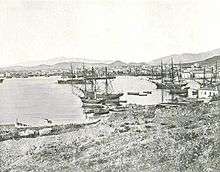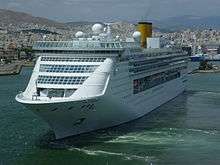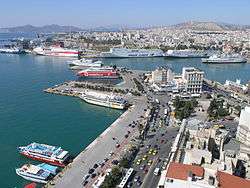Port of Piraeus
| Port of Piraeus | |
|---|---|
|
Part of the port of Piraeus | |
| Location | |
| Country | Greece |
| Location | Piraeus |
| Coordinates | 37°56′31″N 23°38′10″E / 37.941944°N 23.636111°ECoordinates: 37°56′31″N 23°38′10″E / 37.941944°N 23.636111°E |
| Details | |
| Operated by | Piraeus Port Authority (Athex: PPA) |
| Owned by |
(Owner of Piraeus Port Authority:) COSCO Group (67%)[1] Greek Shipping Union (33%)[2] |
| Type of harbor | Natural/Artificial |
| Size | 3.900 ha (35 sq km) |
| Employees | 3.181[3] (2015) |
| President | Giannis Kouvaris |
| Statistics | |
| Vessel arrivals | 47,839 vessels (2014)[4] |
| Annual cargo tonnage | 73.1 million tonnes (2014)[4] |
| Annual container volume |
|
| Passenger traffic |
|
| Annual revenue |
|
| Net income |
|
|
Website www.olp.gr | |
The Port of Piraeus, as the largest Greek seaport, is one of the largest seaports in Europe and the world, located in the Mediterranean Sea basin.[6] The Port of Piraeus served as the port of Athens since the ancient times.[7][8]
Today, the Port of Piraeus is a major employer in the region, with more than 2,500 employees who provide services to more than 40,000 ships and 20.000.000 passengers[9] every year, and is operated by the Piraeus Port Authority S.A.. According to Lloyd's list for top 100 container ports in 2015 Piraeus ranked 8th in Europe and 3rd the Mediterranean sea.[10] This rapid growth is expecting to make Piraeus the biggest commercial port in the Mediterranean by 2016.
History

Until the 3rd millennium BC, Piraeus was a rocky island connected to the mainland by a low-lying stretch of land that was flooded with sea water most of the year. It was then that the area was increasingly silted and flooding ceased, thus permanently connecting Piraeus to Attica and forming its ports, the main port of Cantharus and the two smaller of Zea and Munichia. In 493 BC, Themistocles initiated the fortifications of Piraeus and later advised the Athenians to take advantage of its natural harbours' strategic potential. In 483 BC, the Athenian fleet left the older harbour of Phaleron and it was transferred to Piraeus, distinguishing itself at the battle of Salamis between the Greek city-states and the Persians in 480 BC. In the following years Themistocles initiated the construction of the port and created the ship sheds (neosoikoi), while the Themistoclean Walls were completed in 471 BC, turning Piraeus into a great military and commercial harbour, which served as the permanent navy base for the mighty Athenian fleet. However, in the late 4th century BC began a long period of decline for Piraeus; the harbours were only occasionally used for the Byzantine fleet and the city was mostly deserted throughout the Ottoman occupation of Greece.
Statistics
As of April 2016 the port ranks 39th globally in terms of container capacity.[11] In 2007 the Port of Piraeus handled 20,121,916 tonnes of cargo and 1,373,138 TEU's making it the busiest cargo port in Greece and the largest container port in the country and the East Mediterranean Sea Basin.[4]
| Year | 2007 |
|---|---|
| RoRo* | 1,108,928 |
| Bulk cargo* | 606,454 |
| General cargo* | 6,278,635 |
| Containers* | 12,127,899 |
| Total* | 20,121,916 |
- * figures in tonnes
Terminals
Container terminal
The container part of the port is made up of three terminals:
Terminal 1 with a total capacity of 1 million TEUs
Terminal 2 with a total capacity of 3 million TEUs
Terminal 3, completed in 2016 with a total capacity of roughly 2,7 million TEUs
The total capacity is hence now standing at 6,7m TEUs [12]
Cargo terminal
The cargo terminal has a storage area of 180,000 m2 and an annual traffic capacity of 25,000,000 tonnes.
Automobile terminal
The Port of Piraeus has three car terminals with a total length of 1.4 km, a land area of 180,000 m2, storage capacity of 12,000 cars and a transshipment capacity of 670,000 units per year.[13]
In 2007 the automobile terminal handled 260,605 trucks, 612,840 cars and 9,920 buses.[4]
Passenger terminal

The Port of Piraeus is the largest passenger port in Europe and one of the largest passenger ports in the world with a total traffic of 21,522,917 people in 2007 and 18,635,495 in 2014.[4]
| Years | 2003 | 2004 | 2005 | 2006 | 2007 |
|---|---|---|---|---|---|
| Domestic passengers | 11,713,269 | 11,159,274 | 11,484,763 | 11,668,647 | 11,572,678 |
| Ferry passengers | 8,397,292 | 8,393,053 | 7,977,880 | 7,636,426 | 8,395,492 |
| Foreign passengers | 823,339 | 757,552 | 925,782 | 1,202,190 | 1,554,747 |
| Total traffic' | 20,933,900 | 20,255,879 | 20,388,425 | 20,507,263 | 21,522,917 |
Transportation links

Piraeus station is located next to the Port (37°56′53″N 23°38′35″E / 37.94806°N 23.64306°E), with the southern building the present terminus of Athens Metro Line 1, formerly the Athens-Piraeus Electric Railways that opened in 1869.[14] The northern building is the railway terminus for standard gauge railway services on the main axis to Eidomeni via Larisa and Thessaloniki, and the Proastiakos to Chalcis and Acharnes Junction.[15]
Free shuttle buses inside the Port run from across the Metro Line 1 Terminal Station, around the north side of the port to the ships sailing for Crete, the Eastern Aegean and the Dodecanese. A direct Airport Express bus runs 24/7 between the port and Athens International Airport. Other public buses connect Piraeus with its outlying suburbs, the southern coastal zone and with central Athens.
References
| Wikimedia Commons has media related to Piraeus harbor. |
- ↑ http://www.zougla.gr/money/article/olokliro8ike-to-deal-1357819
- ↑ http://www.zougla.gr/money/article/olokliro8ike-to-deal-1357819
- ↑ "Port of Piraeus number of employees". Olp.gr. 2008-10-30. Retrieved 2009-09-23.
- 1 2 3 4 5 6 7 8 9 "(Container Terminal)" (PDF). Retrieved 2009-09-23.
- 1 2 "Reuters report". Reuters.com. Retrieved 2009-09-23.
- ↑ "Port of Piraeus container port". Greek-islands.us. Retrieved 2009-09-23.
- ↑ Στρατηγική - Όραμα (in Greek). Piraeus Port Authority S.A. Retrieved 2010-09-26.
- ↑ Hellander, Paul (2008). Greece. Lonely Planet. ISBN 1-74104-656-4.
- ↑ https://panethos.wordpress.com/2013/12/18/europes-busiest-passenger-seaports/
- ↑ https://www.lloydslist.com/ll/incoming/article506151.ece
- ↑ "Greek president hopes for more investments following Piraeus Port Authority deal". Hellenic Shipping News. 11 April 2016. Retrieved 13 April 2016.
- ↑ http://mixanikosose.blogspot.nl/2016/05/cosco_29.html
- ↑ "Car Terminal". Olp.gr. Retrieved 2009-09-23.
- ↑ http://www.isap.gr/eng/page.asp?id=44 Retrieved 7 February 2011.
- ↑ 2012 Network Statement (pdf), Athens: OSE, 2012, p. 3.3
